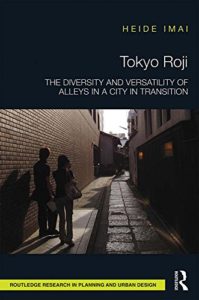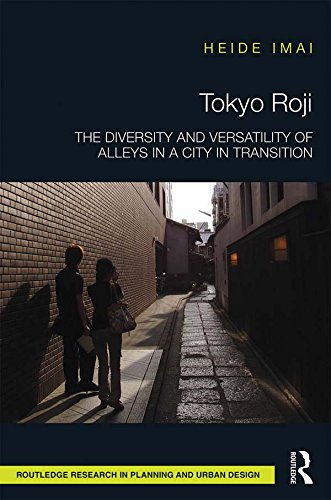

Support BOA by ordering Tokyo Roji through these links:
Amazon U.S.
Barnes & Noble U.S.
Amazon Japan
Thanks for helping support Books on Asia!

An academic book about Tokyo’s alleyways from Routeledge Press.
The Japanese urban alleyway, which was once part of people’s personal spatial sphere and everyday life has been transformed by diverse and competing interests. Marginalised through the emergence of new forms of housing and public spaces, re-appropriated and re-invented by the contemporary urban design, the social meaning attached to the roji is being re-interpreted. Tokyo Roji highlights practices of contemporary Tokyo to portray the life cycle of an urban form being rediscovered, commodified and lost as physical space.
“Heide Imai evokes the subtle complexity of Tokyo’s traditional back streets in a way that resonates with all cities struggling to be simultaneously local, global, and modern. This book is tremendously useful for shaping a deeper understanding of, and better tools for, historic preservation and community planning in Asia and throughout the world.”
Sharon Zukin, author, Naked City: The Death and Life of Authentic Urban Places
“By emphasizing on the importance of the sense of place and the ordinariness, this book takes the readers to the roji of contemporary Tokyo. Using multiple insightful urban narratives, Heide Imai skilfully unfolds the various facets of neighbourhoods of these hidden urban spaces.”
Davisi Boontharm, International Program of Architecture and Urban Design, Meiji University, Japan
The yin and yang of Tokyo: Nezu and Yanaka and the mixed used roji
Between Soba and Curry Pan, Tuesday around Noon, Mid September, between Nezu and Yanaka.
Arriving in Nezu on this early autumn day, I walk along the busy Shinobazu Street full of buses, cars and people, most of them tourists on their way to the Nezu Shrine. I am on my way to the local soba shop. Soba is a type of noodle made out of buckwheat flour, crunchy and soft at the same time. The local noodle maker is known for his soba combinations with duck or grilled unagi (eel). The soba shop is located behind the Nezu Shrine at the end of a narrow alleyway.
I am surprised that in contrast to the external appearance, which looks like an old dwelling, the shop is fashionably furnished with just three tables, expressing the owner’s interest to just cook for a small crowd, knowing that many people will leave the place without having the chance to enjoy the great taste of his freshly made buckwheat noodles. Thus, I know I am lucky, as I am invited by a local friend, Miura-san, who knows the owner and comes here every week for a chat and drink. Hayashi-san, the owner, greets us with a smile and waves with his hands the way to the only empty table at the end of this little place.
My acquaintance orders some brown, thin soba and to my surprise, a small bottle of local sake from Niigata together with some nibbles like fish balls, omelettes and pickles. When I ask my friend why she has ordered sake for lunch she starts laughing loud and wholeheartedly. Shortly after, she explains that once she realized that she got old, she does not care anymore what others think but enjoys the small things in life that make her happy. The owner brings the bottle and says with an even louder voice “kampai (cheers).” It seems that they have known each other for a long time, sharing not just the age and neighbourhood, but also countless stories of everyday life I am happily listening to and trying to follow with my Japanese not always being able to catch the local Edo ben (Edo dialect), which sounds to me like the rakugo speech (type of Japanese storytelling for entertainment), typically performed in shitamachi areas like Nezu.
Some days later, I wander along the alleyways of Yanaka to meet a young mother who is living in an alleyway nearby. Standing in front of an old house in which a famous writer lived, we recognize that just behind us, a new house has been constructed, one of the many pencil-like structures that emerged in the last few years in this neighbourhood. We greet each other and continue our walk along this alleyway. Some sun rays enter the street, and the air is moist, but a light wind is coming from the other end of the alleyway. We cross the main street and the mother, Ito-san, explains that she wants to take me to a new café, which she started to use to get her work done as freelance writer, a profession she loves and combines with her time she spends in this ‘micro version of Tokyo’, an expression she uses when fondly talking about Yanaka. We sit down and order some hōjicha latte (a type of Japanese tea with hot milk) and karē pan (curry buns), local delicacies and a must-tries. Listening to the Brazilian Bossa Nova playing in the backdrop and studying the menu, I spot other interesting fusions such as matcha egg salad, pickled spring onion sandwiches and ginger lemonade made from local Yanaka ginger. Soon after, we start to exchange our first impressions, and it is obvious why my acquaintance, Ito-san, a newcomer to Yanaka, loves this new place.
Nezu and Yanaka
Most visitors to Tokyo envision the city as a mix of futuristic skyscrapers and glamorous advertisings, yet in some parts of the city, a slower, older and more traditional way of life prevails. One district in the eastern city area, known as YaNeSen, made up the neighbourhoods of Yanaka, Nezu and Sendagi. The three neighbourhoods share a long history, traditions and specific everyday life features characteristic for this low-city part of Tokyo. Re-discovered in the 1980s, nowadays it is a mix of traditional craft and rice-cracker shops coexisting with modern art galleries, cafés and bakeries. The area is attracting more and more people to walk the streets and alleyways, which offer a human-scale atmosphere unlike other high-rise areas in Tokyo. And although the neighbourhoods mirror different realities, poetics and politics, they are spatially as well as socially closely intermingled.
The neighbourhood of Nezu
Nezu is a neighbourhood in the Bunkyo Ward, in which currently 6,291 residents live (2015). Nezu is located in a part of Tokyo that escaped the damages of the 1923 Earthquake and the bombing of the Second World War, next to a few other areas such as Yanaka. Having remained un-shattered from these two events, the area is said to represent the character of shitamachi, the low city in which people lived in close proximity and interaction together. Nowadays, a popular place for town walks, which were started in the 1980s around Mori Mayumi’s Yanesen Group, the area is in high demand. Regularly featured on TV and magazines, new galleries, cute pop-up stores, cafés and other corners of everyday life appear in the dense urban neighbourhood, promising to soon become one of the next urban trends.
Nezu and Yanaka Nezu was especially known as a yūkaku or red-light district. Due to its location so close to the prestigious Tokyo university and the high number of prostitutes (at its peak, 574 women were employed in the Nezu brothels), the pleasure district was moved to Susaki, East Tokyo in 1888. As there is nothing left that indicates that Nezu was once a quarter for pleasure, one can only imagine how everyday life was in these narrow, hidden streets and alleyways. Nezu is traditionally characterized by small lanes and alleyways along block-shaped plots with dense, low-rise housing of local shopkeepers, merchants and craftsmen and famous for its shrine, which attracts a diverse clientele, which enjoyed in the past all kinds of entertainment activities. These are features of the past, however, the narrow lanes and remaining low-rise dwellings still indicate that this area was and still is partly the home of a ‘lower’ shitamachi class. Since the 1960s, the area changed gradually, as the main street, Shinobazu Dōri (dividing the area of Nezu in the middle), was developed by the establishment of the new Chiyoda subway line underground, allowing the emergence of more cars on top; the widening Shinobazu Street from 16 to 22 m (allowing the construction of a large number of new high-rise buildings).
Accordingly, it is argued that Shinobazu Street divides the neighbourhoods of Nezu 1-and 2-chōme forming a ‘wall’ between the two areas, which was before spatially and socially connected but is now increasingly separated. Due to the lack of support coming from the local ward office or an active local town planning group (like found in other neighbourhoods such as Yanaka), we can observe that more and more pencil-like high-rise buildings appear along the side and backstreets, penetrating the low-rise, soft core; fragmenting the neighbourhood on the social and spatial level; and repeating the soft core/ hard shell pattern on an increasingly smaller scale (Popham 1985). These ‘vulnerable’ areas are not prepared for the demands of the new clientele, being, for example, inaccessible by car. Yet, Nezu still somehow retains the character of an Edo neighbourhood, as “… Nezu and its surrounding areas have managed to avoid excessive attention from the tyrants of trend and fashion. In other words, they have struck a happy balance between craving for the future and basking in the past” (Waley 1991, 191). Similarly, Muminović (2014) argued that Nezu keeps a good balance between endurance and transformation, maintaining a comfortable identity situating itself between its rich history and contemporary development. In her work, she extensively analyses facades of dwellings, demonstrating that the few old houses that remain are not clustered together and that the majority of them have contemporary facades using non-wooden materials. Despite these changes, the neighbourhood still has the typical shitamachi charm, showing that the atmosphere is not just based on historical buildings and their preservation, but it is much more the diversity and complexity of the whole mix that determines the flair of the area.”
